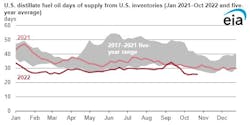EIA: Strong demand for diesel leads to high prices going into winter
Strong demand for ultra-low sulfur diesel (ULSD, the most widely consumed form of distillate fuel oil) in October, combined with reduced global production, has resulted in higher ULSD prices and lower inventories in the US, the US Energy Information Administration (EIA) said.
“Current inventories and our current estimate of future demand can be combined into a metric called days of supply, which is calculated by dividing the inventory (in bbl) by the estimated demand (in b/d) to get the number of days that inventories alone could meet demand. In October 2022, the US had 25 days of supply of distillate, the fewest since 2008. US days of supply between 2017 and 2021 averaged 34 days. US inventories of distillate fuel oil have been below the previous 5-year (2017–21) low since the start of 2022,” EIA said.
Days of supply, however, is not a complete snapshot of distillate fuel oil availability because it doesn’t consider production, imports, or any sources of supply other than inventories, EIA noted.
In October 2022, the New York Harbor spot price for ULSD averaged $4.36/gal, the highest monthly price since May 2022. The increase in diesel prices, both in the US and globally, has been the result of several factors, such as tight global inventories, reduced refinery production in Europe following labor strikes, and the start of seasonal demand for distillate as a home heating fuel.
Reduced refining capacity in the US and globally since 2020 is one of the main reasons for low distillate inventories in the US. Distillate fuel consumption this year, through August, remained below pre-pandemic levels but was higher than in 2020. More distillate consumption combined with less distillate production contributed to the lower inventories. Increasing demand in October, measured as product supplied, contributed to greater pressure on those inventories and resulted in a decrease in October days of supply relative to September.
“The Northeast—the combined New England and mid-Atlantic regions—has had even tighter inventories than the US average. Lower inventories have contributed to rising prices in the region. US distillate demand is seasonal; specifically, consumption increases in the winter because it is used for home heating, mostly in the Northeast,” EIA said.
